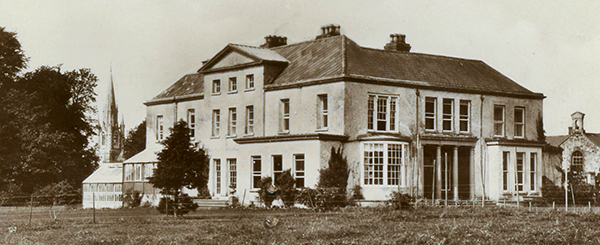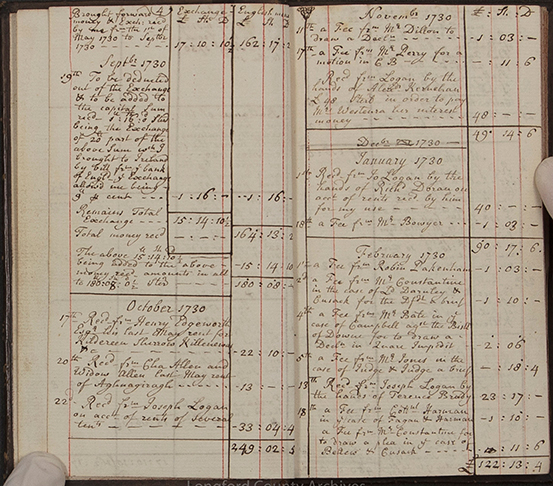RICHARD EDGEWORTH’S ACCOUNT BOOKS
Published in Issue 2 (March/April 2022), Volume 30By Martin Morris
Have you ever wondered what it cost to buy chocolate or sugar 300 years ago? Or the cost of dinner, or a servant’s wages? You will find the answers to these questions, and others, in two account books held in Longford County Library and Archives Services. They were kept by Richard Edgeworth of Edgeworthstown, Co. Longford. One covers the period 1727–9 and the second 1730–2, and both are in the Edgeworth Papers. The books are remarkable for what they tell us about the lifestyle and character of the man who owned them, and for what they reveal about the cost of living at that time.
Richard Edgeworth (1701–70) was a member of one of Longford’s major landed families, with an estate mostly in Mostrim parish. His grandfather, Sir John, founded the town that bears the family’s name. Sir John’s successor, Francis, inherited debts and a neglected estate, and was involved in costly family litigation. Francis and his third wife Mary died within days of each other in 1709, leaving eight-year-old Richard as their orphaned heir. His was an unenviable inheritance!
Fortunately, Richard was taken by his half-sister, Margaret Pakenham, and her husband Edward to live with them in Pakenham Hall, near Castlepollard, Co. Westmeath. After Edward’s death, Walter Nugent of Carpenterstown, Co. Westmeath, became Richard’s guardian. Richard went on to study law, and over time, through hard work and good management, he cleared debts that amounted to about £7,000.
The account books are from the period preceding Edgeworth’s marriage to Jane Lovell (daughter of a Welsh judge) in 1732. For the duration of the first, he was living in London. He returned to Ireland in September 1730 and was called to the bar in November of the same year. Both books record, in meticulous detail and in small but very neat writing, his daily expenditure, with monthly totals calculated.
There are other transactions, too, such as details of some rents and other monies received. Each book measures about 15cm by 9cm, and there can be little doubt that Edgeworth carried the ‘current’ book with him so that he could record expenses as they arose.
There are numerous references to necessities such as coal, candles, clothing, foodstuffs, laundry, household items and coach hire. On some days he had multiple expenses. At times he listed several items in a single entry. On 5 April 1728 we learn that he paid £1 and one shilling for ‘new sleeves to my night gown, & for a cover to my tea table & making thereof; for a new lining to my velvet cap & for a tea kettle’. Interestingly, there are many references to the mending of garments in both books. Of course, there are numerous expenses that could only be incurred by someone of Edgeworth’s socio-economic status. He made regular payments for dinners, suppers and ‘coffee house expenses’. One particular dinner in Edgeworthstown on 11 September 1731 cost six shillings and sixpence.

Above: Edgeworthstown House, which was rebuilt and extended by Richard Edgeworth. (Longford County Library and Archives)
There were many purchases of luxury items like chocolate and sugar. At that time chocolate was popular as a drink amongst the rich. In one instance, where the amount of chocolate is specified (1 June 1730), Edgeworth paid four shillings for a pound of it. That was the equivalent then of two days’ wages for a skilled tradesman and the approximate equivalent of €28 today. Sugar was cheaper: for example, on one occasion (11 December 1730) Edgeworth paid sevenpence for a half-pound of it. There are many references to his buying oranges and lemons, often with other items, and to wine, rum and tobacco.
Edgeworth had servants, some of whom are named, including Thomas Lynch, Thomas Paine and Harry Fryar. On 4 March 1727/8 Edgeworth paid his servant a week’s wage of five shillings and threepence, equal to roughly €36 today. Richard had an active social life and there are mentions of trips to operas and plays. On 2 March 1727/8 he went to see The Beggar’s Opera by John Gay, which was first performed only weeks earlier. The admission charge was three shillings. Occasionally, Edgeworth also noted money ‘lost at play’ and money won at cards. The entries from his time in London include some mentions of a woman referred to only as ‘Philoclea’. Edgeworth paid for breakfasts, dinners, wine and at least one present for her, so obviously they were close.
The books reflect his close relationship with the Pakenham family. At the end of the first one is a section entitled ‘My nephew Pakenhams [sic] accounts’, where Edgeworth recorded monies spent on Thomas Pakenham (later 1st Baron Longford) in 1727–8. Then aged fourteen years, Tom visited Edgeworth in London in December 1727. His uncle paid for gloves for him, brought him to see a performance of The Tempest, treated him to dinners and gave him pocket money. Some of that expenditure was by way of repayment of money owed to Tom’s mother, Margaret. Edgeworth’s return to Ireland was a watershed moment in his life. He settled into practising law and managing his estate, and of course, from 1732, into married life. In a rare non-financial entry, on 8 March 1731/2 he noted: ‘Signed my marriage settlem[en]t this night’.

Above: One of the account books, showing details of rents received, 1730–1. (Longford County Library and Archives)
Edgeworth went on to have a long career in politics, serving as MP for Longford borough, 1737–60. His son and successor, Richard Lovell Edgeworth (1744–1817), described his father as ‘upright, honourable, sincere, and sweet tempered’. He also reflected on how ‘early difficulties had accustomed him to laborious business at the desk, and to uncommon accuracy’. Richard Lovell inherited his father’s acumen and was an inventor, educationalist and improving landlord. His daughter, Maria (1768–1849), was a distinguished author and educationalist.
The account books are part of a much larger series, most of the rest of which is in the National Library of Ireland (MS 1507–9, 1510–24).
Martin Morris is Longford County Council Archivist and a member of the Local Government Archivists and Records Managers (LGARM).
















